2. 中国地质大学(北京), 北京 100083;
3. 南方海洋科学与工程广东省实验室(广州), 广州 511458;
4. 应急管理部国家自然灾害防治研究院, 北京 100085
2. China University of Geosciences, Beijing 100083;
3. Southern Marine Science and Engineering Guangdong Laboratory (Guangzhou), Guangzhou 511458, China;
4. National Institute of Natural Hazards, Ministry of Emergency Management of China, Beijing 100085, China
断裂岩是断层作用的直接产物,其岩石组成和内部结构蕴藏着断裂活动过程中滑移性质、力学状态、物理-化学过程和流体作用等重要信息(Wibberley et al., 2008; Faulkner et al., 2010)。断裂岩物质组成、结构构造和物理化学性质是认识断裂变形行为、滑移机制和地震破裂过程的基础和关键(Chester et al., 1993; Schleicher et al., 2010; Gratier et al., 2011; Holdsworth et al., 2011; Scholz, 2002)。鲜水河断裂带位于青藏高原东南缘,是世界上地震活动性最强的活动断裂带之一(Molnar and Deng, 1984; Wen et al., 2008)。历史地震及仪器记录地震统计结果显示,自1725年以来沿鲜水河断裂带先后发生了6级以上强震17次,其中7级以上破坏性强震8次,包括1893年乾宁7.0级大地震、1973年炉霍7.6级大地震(Allen et al., 1991; Deng et al., 2003; 张培震等, 2003; Papadimitriou et al., 2004; Wen et al., 2008)。2008年汶川地震(Mw7.9)过后,鲜水河断裂带的库伦应力急剧增加(Parsons et al., 2008; Toda et al., 2008; Yang et al., 2015),发生破坏性强震的概率变大。前人对于鲜水河断裂带的认知多集中在构造地貌与滑移速率(Bai et al., 2018)、大地测量学(GPS与InSAR)(Ji et al., 2020)、库伦应力特征(Toda et al., 2008)、古地震(李东雨等, 2017)、年代学(Zhang et al., 2004a)、地质灾害(Zhang et al., 2017)等方面,然而,从断裂岩角度出发的研究较少(杨主恩等, 1999; 彭东等, 2012; Wang et al., 2014),尤其在断裂变形行为、滑移机制和地震机理等方面的研究进展缓慢。因此,亟需对鲜水河断裂带在地震过程中形成的断裂岩进行详细研究,依据其结构构造确定断裂变形行为,通过物质组成与物理-化学性质揭示其滑移机制,由此探讨鲜水河断裂带强震频发的力学行为,这对认识断裂带应力聚集过程和地震活动性具有重要意义。
鲜水河断裂带乾宁段(道孚-八美)有曾发生过5次M6.5级以上大地震的记录,其中震级最高为1893年8月29日M7.0乾宁大地震。在甘孜州八美镇龙灯乡促涅隆巴河沟内,可见清晰的乾宁大地震地表破裂带,晚第四纪阶地位错明显,阶地上发育的断层槽谷与地表冲沟内出露的断裂岩带位置相对应。本文以该地表出露的断裂岩带为研究对象,对断裂岩露头剖面进行了定向样和化学样的系统采集,并通过显微构造观测、XRD矿物半定量分析和XRF、EDS元素面扫等研究,确定断裂带物质组成、内部结构、物理-化学性质,进而探讨其变形行为和滑移机制。
1 地质背景青藏高原东缘是我国“南北地震带”的主体部分(Deng et al., 2003; Zhang, 2013)。由于青藏高原向东扩展挤出,并与东部刚性四川盆地发生碰撞,该区域发育大量活动断裂(Molnar and Tapponnier, 1975; Tapponnier and Molnar, 1977; Wang and Burchfiel, 2000; Tapponnier et al., 2001),鲜水河大型左旋走滑断裂带就是其中之一(图 1a)。鲜水河断裂带位于松潘-甘孜造山带内部,分割了北东侧的巴颜喀拉地块和南西侧的川滇地块(图 1a),是青藏高原物质相对于欧亚大陆围绕东喜马拉雅构造节顺时针旋转的北界(Zhang et al., 2004b; Wang et al., 2017; Wang and Shen, 2020),也是中国大陆内部构造活动性最强、强震频发的活动断裂(Allen et al., 1991; Wen et al., 2008)。
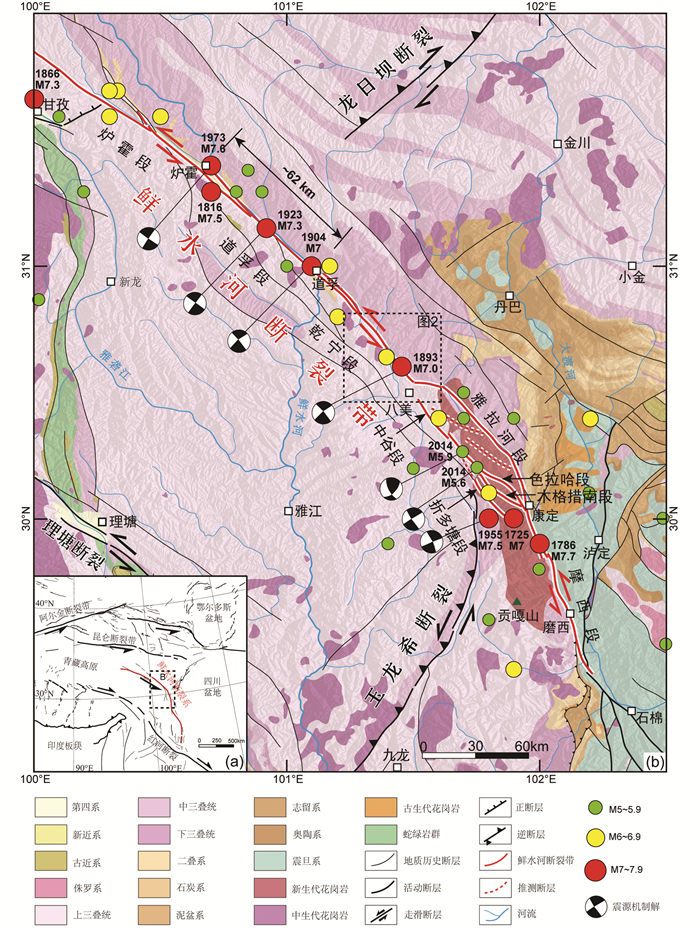
|
图 1 青藏高原东南缘区域构造地质图 (a)青藏高原及其邻区构造简图(据Bai et al., 2018修改);(b)鲜水河断裂带构造地质图及沿断裂大地震分布图(据Papadimitriou et al., 2004; 潘家伟等, 2020; 中国地质调查局成都地质矿产研究所, 2004①) Fig. 1 Regional geological maps of southeastern Tibetan Plateau (a) sketch tectonic map of the Tibetan Plateau and its adjacent arears (modified after Bai et al., 2018); (b) tectonic geological map of Xianshuihe fault zone and distribution of large earthquakes along it (after Papadimitrio et al., 2004; Pan et al., 2020) |
① 中国地质调查局成都地质矿产研究所. 2004. 1/150万青藏高原及邻区地质图
鲜水河断裂带北西起自甘孜卡苏一带,向南东经炉霍、道孚、康定、摩西一线,至石棉安顺场一带逐渐减弱消失,全长约400km,总体走向北西320°~330°,几何形态呈略向北东凸出的弧形(图 1b),为一条全新世强烈活动的大型左旋走滑断裂带(闻学泽等, 1989; Bai et al., 2018)。该断裂带在甘孜至八美之间呈连续线性展布,鲜水河被断裂左旋错开~62km(Yan and Lin, 2015; Bai et al., 2018)(图 1b)。断裂向SE延伸,过惠远寺盆地后发散为呈右阶雁列式分布的三条分支断裂:北边的雅拉河断裂、中间的色拉哈断裂以及南边的折多塘断裂。雅拉河断裂与色拉哈断裂在康定附近合并为磨西断裂,断裂几何形态显示这三条断层在深部可能是连在一起的(Allen et al., 1991; Jiang et al., 2015)。潘家伟等(2020)通过高分辨率卫星影像解译和详细的野外填图在色拉哈断裂和折多塘断裂之间的折多山花岗岩体内新发现了一条长约24km的全新世活动断层,将其命名为“木格措南断裂”(图 1b)。
鲜水河断裂带切过不同时代、不同岩性多套地层,主要包括志留系、泥盆系、石炭系、二叠系、三叠系、第四系以及不同时期岩浆岩等(辜学达和刘啸虎, 1997; 中国地质调查局成都地质矿产研究所, 2004)。三叠系为鲜水河断裂带两盘的主体岩石地层,包括菠茨沟组、扎尕山组、杂谷脑组、侏倭组、新都桥组、如年各组、两河口组、雅江组,其中以上三叠统分布最广、厚度最大,主要岩性为浅变质的砂、板岩地层。此外,鲜水河断裂带岩浆岩也较为发育,以南东段折多山岩体规模最大。本文选取的研究区内,断层切过上三叠统侏倭组(图 2),岩性主要为灰色-深灰色薄层-厚层状变质细粒石英砂岩、长石石英砂岩、粉砂岩与灰黑色粉砂质绢云板岩、碳质绢云板岩组成有频繁韵律式互层,偶见斑岩岩脉。
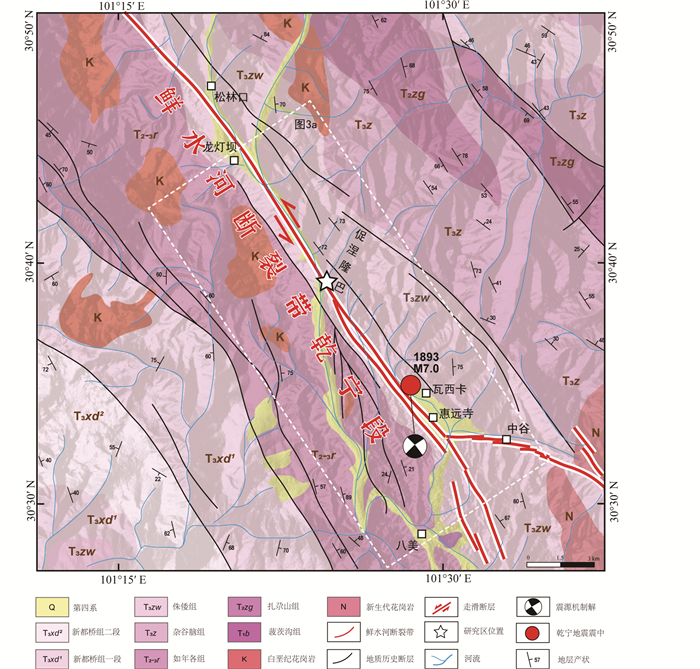
|
图 2 鲜水河断裂带乾宁段构造地质图及研究区位置(据四川省地质局, 1981②, 1985③; 四川省地震局, 1995④修改) Fig. 2 Geological map of Qianning segment in Xianshuihe fault zone and the location of study area |
② 四川省地质局. 1981. 1/20万丹巴幅地质图
③ 四川省地质矿产局. 1985. 1/20万康定幅地质图
④ 四川省地震局. 1995. 1/5万鲜水河活动断裂带地质图
2 样品采集与研究方法 2.1 样品采集为确保主滑移带样品的连续性和完整性,我们对促涅隆巴河沟内发育的断层泥、碎裂岩和断层角砾岩进行岩石整块定向取样,样品尺寸为28cm×10cm×10cm,包含了黄色断层角砾岩、黑色断层泥和灰色碎裂岩,并对浅黄色断层角砾岩和灰色断层角砾岩进行单独采样。根据野外实际测量,沿着平行于断层面走向、垂直于断层面的切面(即XZ面)切制定向薄片,同时对断层泥、碎裂岩和断层角砾岩分别进行1cm一个样品连续粉末样采集和3cm间隔粉末样采集,共获得25个粉末样品,其中1个浅黄色断层角砾岩,7个黄色断层角砾岩,4个黑色断层泥,12个灰色碎裂岩,1个灰色断层角砾岩。
2.2 研究方法我们对主滑移带断裂岩定向样品进行切割磨制构造岩石薄片,切制的薄片通过偏光显微镜和扫描电镜进行显微构造观测与分析,显微构造观测在自然资源部深地动力学重点实验室完成。利用Nano Measurer软件统计主滑移带内石英碎屑粒径,每个统计区域宽40μm,长150μm,长边方向与主滑移带平行,依据粒径分布特征划分不同期次滑移带。矿物成分分析是将25个断裂岩样品碾磨成粉末做矿物半定量分析,采用的方法是SY/T5163—2018沉积岩中黏土矿物和常见非黏土矿物X射线衍射分析方法(XRD),测试仪器为X射线衍射仪(D8 Advance)。该实验在北京北达燕园微构分析测试中心有限公司完成。此外,通过微区X射线荧光分析仪(XRF)及EDS能谱分析对主滑移带定向薄片开展化学元素面描,该实验在自然资源部深地动力学重点实验室进行。
3 断裂带地貌特征、岩石组成与结构构造 3.1 地表构造地貌特征研究剖面位于八美镇北西方向约20km促涅隆巴河沟内,该处地表断裂行迹清晰,表现为连续线性展布,总体走向N328°W(图 3a)。研究区内发育两条水系,二者共同作用形成至少5级河流相阶地。断裂切割T4阶地,可见约100m的左旋位错(图 3b)。研究区T4阶地上沿断层走向可观察到连续发育的两侧高中间低、宽22~26m、深约1.79~8.75m的断层槽谷,与地表冲沟内出露的断裂岩带位置相对应(图 3c, d)。从地貌特征可知,鲜水河断裂乾宁段在该处有左旋兼正断的运动特征。
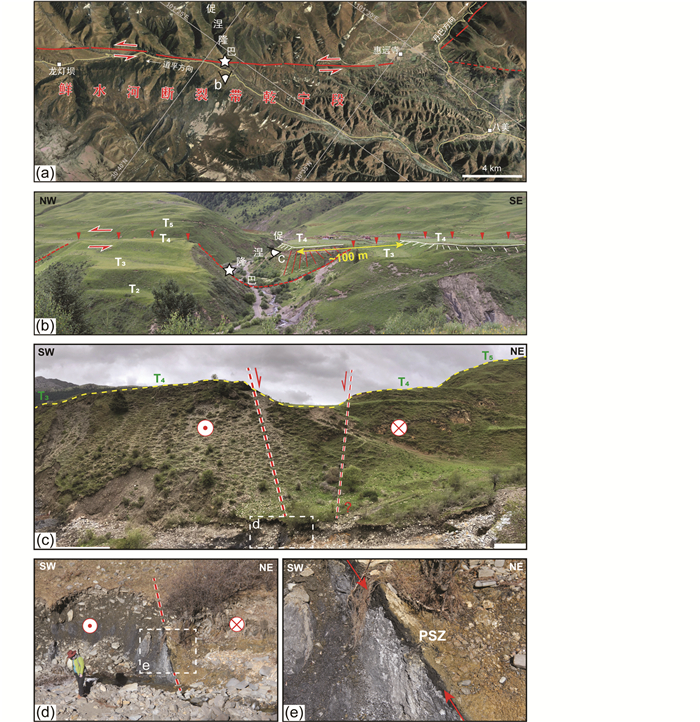
|
图 3 鲜水河断裂带乾宁段构造地貌特征与断裂带野外露头 (a)鲜水河断裂带乾宁段卫星影像,白色星号为研究区位置;(b、c)断裂带构造地貌特征,T3、T4、T5分别表示河流三级阶地、四级阶地、五级阶地;(d、e)断裂带野外露头,PSZ-主滑移带 Fig. 3 Tectonic geomorphic features and filed outcrop of Qianning segment in Xianshuihe fault zone (a) satellite image of Qianning segment in Xianshuihe fault zone. The white star marks the location of study area; (b, c) tectonic geomorphic features of the fault zone, T3, T4 and T5 representing Ⅲ terrace, Ⅳ terrace and Ⅴ terrace of the river, respectively; (d, e) field outcrop of the fault zone; PSZ-Primary Slip Zone |
鲜水河断裂带乾宁段断裂岩在促涅隆巴河沟两侧均有出露(图 3e、图 4),断裂岩整体宽约14.3m,以黑色断层泥为中心,两侧分别发育浅黄色、黄色断层角砾岩和灰色碎裂岩、灰色断层角砾岩(图 4a)。浅黄色、黄色断层角砾岩带出露宽度约6.2m,浅黄色断层角砾岩内可见次级滑移带,带内断层泥较脆易破碎并发育面理(图 4c),黄色断层角砾岩呈现脉体特征(图 4b, d)。主滑移带断层泥厚3~5cm,呈黑色弱固结,可见弱面理,与其两侧断裂岩界线清晰、平直(图 4e, f)。灰色碎裂岩带宽约0.9m,发育弱面理,内部方解石脉体与弱面理近于平行。灰色断层角砾岩内角砾粒径明显增大,内部可见两组面理,方解石脉较为发育(图 4g, h)。
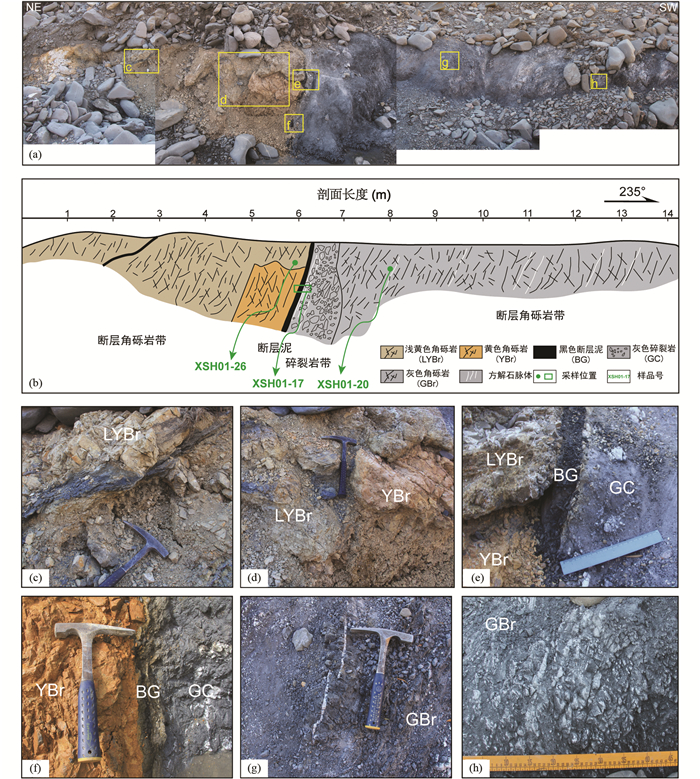
|
图 4 鲜水河断裂带乾宁段野外露头断裂岩分布特征 (a、b)断裂岩野外剖面及素描;(c-h)断裂岩野外露头特征,断裂岩缩写见图b中图例 Fig. 4 Distribution characteristics of fault rocks in field outcrop of Qianning segment in Xianshuihe fault zone (a, b) field profile and sketch of fault rock; (c-h) field outcrop characteristics of fault rock. The abbreviations of fault rocks are shown in the legend of Fig. 4b |
促涅隆巴河沟内出露的断裂岩由断层泥、碎裂岩和断层角砾岩等组成,并构成断裂带核部物质。从NE向SW断裂岩依次为:浅黄色断层角砾岩内部角砾大小不均,分布杂乱,局部角砾被方解石胶结(图 5a);黄色断层角砾岩原岩为斑岩,与浅黄色断层角砾岩接触界线截然,在与黑色断层泥的接触带上角砾细粒化更为明显,角砾直径1~5cm不等,由黄色黏土基质胶结(图 4f、图 5a);黑色断层泥内颗粒较为细小,手标本上未见明显角砾;灰色碎裂岩在XZ切面发育弱面理,角砾沿面理定向分布,方解石脉体碎裂(图 5b)。灰色碎裂岩内靠近黑色断层泥一侧方解石较多,面理与主滑移面近于平行(图 5b)。灰色碎裂岩内发育里德尔剪切系R、P、T等多个方向的次级剪切破裂,其中以P和R破裂居多,方解石充填在T破裂内(图 5c)。
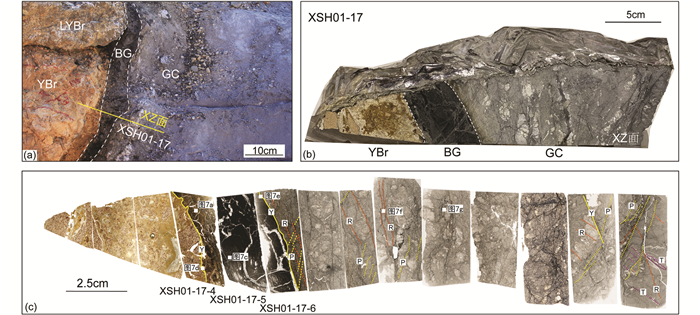
|
图 5 鲜水河断裂带乾宁段主滑移带断裂岩野外露头及宏观特征 (a)主滑移带断裂岩野外露头,断裂岩缩写参见图 4b,黄线表示图b手标本切面方向,白色虚线内为黑色断层泥;(b)主滑移带样品垂直断层面、平行其走向的手标本剖面;(c)图b手标本连续薄片;黄色实线、黄色虚线、橘色虚线、紫色虚线分别代表里德尔剪切系内“Y”、“P”、“R”和“T”方向剪切 Fig. 5 Field outcrop and macroscopic characteristics of fault rocks in primary slip zone of Qianning segment, Xianshuihe fault zon (a) field outcrop of fault rocks in PSZ. Refer to Fig. 4b for the abbreviation of fault rocks; the yellow solid line indicates the cutting direction of hand specimen in b; the white dotted lines are boundaries of black fault gouge; (b) the cutting surface of hand specimen of PSZ, which is perpendicular to the fault plane and parallel to the strike of it; (c) continuous thin sections of hand specimen in b; yellow solid line, yellow dotted line, orange dotted line, and purple dotted line represent "Y", "P", "R" and "T" in Riedel shear system, respectively |
断层泥在光学显微镜下呈深棕色-黑色,发育弱面理(图 6c)。断层泥内发育一系列石英、长石碎块,其粒径大小不均,碎块既有棱角分明,也有浑圆状,较大的长石碎块内部可见一组平行破裂(图 6a)。石英碎块多呈棱角状,其周缘可见由黏土矿物组成的蚀变边(图 6b)。显微构造观察中发现两处断层泥楔入脉:靠近黄色断层角砾岩一处,断层泥楔入到斑岩角砾内,楔入脉体长1~2mm,最厚约0.3mm,两条断层泥楔入脉近于平行(图 6d);另一处靠近灰色碎裂岩一侧,含有较粗粒径石英碎屑的断层泥脉楔入到其左侧石英粒径较细小的断层泥内,二者之间界线明显、较平直(图 6e)。灰色碎裂岩发育弱面理,碎裂结构明显,角砾多为棱角分明的石英碎屑,角砾之间被深棕色-黑色黏土矿物胶结(图 6f, g)。灰色断层角砾岩内角砾为砂岩碎块,角砾之间无明显位移,发育弱面理(图 6h)。

|
图 6 鲜水河断裂带乾宁段断裂岩光学显微镜下结构特征 (a、b)黑色断层泥由长石、石英碎屑和黏土矿物组成,石英具有蚀变边;样品号标于照片左上角;(c)黑色断层泥内可见弱面理;(d、e)断层泥楔入脉;(f、g)灰色碎裂岩,可见弱面理;(h)灰色断层角砾岩 Fig. 6 Structural characteristics of fault rocks in Qianning segment of Xianshuihe fault zone under optical microscope (a, b) black fault gouge is composed of feldspar, quartz and clay minerals, and quartz has altered edge; the sample numbers are marked in the upper left corner of the photos; (c) weak foliation can be seen in the black fault gouge; (d, e) fault gouge injection veins; (f, g) gray cataclastic rock with weak foliation; (h) gray fault breccia |
扫描电镜观测结果显示,黑色断层泥是由大小不一、分布杂乱、磨蚀程度不同的石英、长石、方解石碎屑和黏土矿物组成(图 7)。石英含量最高,颗粒具有溶蚀特征;云母只在局部出现且呈弱定向排列;长石多发生蚀变(图 7a, b)。断层泥内部碎块粒径大小分带明显,有的粒径差异较大,且条带之间界线清晰平直,它们代表不同期次的滑移带(图 7c-f)。在断层泥与灰色碎裂岩的接触带上,发现大量的方解石颗粒充填在角砾裂隙和基质孔隙内(图 7g),方解石颗粒细小,粒径一般小于1μm。另外,扫描电镜下亦可观察到断层泥楔入到斑岩角砾中(图 7h)。
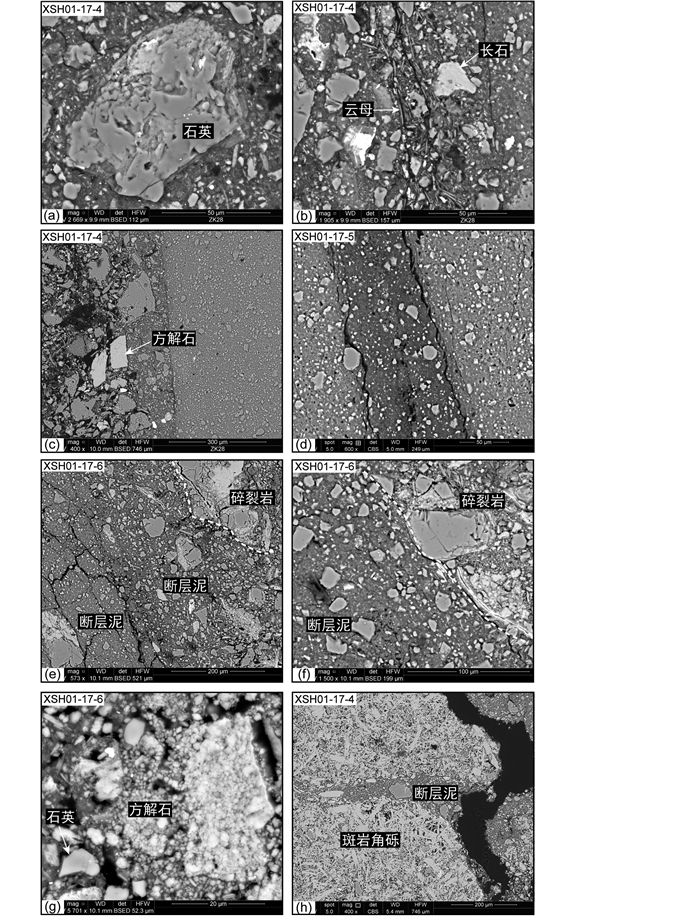
|
图 7 鲜水河断裂带乾宁段断层泥扫描电镜下显微结构特征 (a)靠近黄色断层角砾岩一侧断层泥内石英颗粒的溶蚀特征;(b)断层泥内长石蚀变,云母成弱定向;(c-e)断层泥内部碎块粒径大小分带明显,条带之间界线清晰平直;(f)靠近灰色碎裂岩一侧断层泥内石英碎屑基本无溶蚀特征;(g)方解石颗粒充填在角砾裂隙和基质孔隙;(h)断层泥楔入脉 Fig. 7 Microstructure characteristics of fault gouge of Qianning segment in Xianshuihe fault zone under scanning electron microscope (a) dissolution and alteration characteristics of quartz particles in fault gouge near yellow fault breccia; (b) feldspar alteration and mica weak orientation in fault gouge; (c-e) the particle size distribution of fragments in fault gouge is obvious, and the boundaries between zones are clear and straight; (f) the quartz particles in the fault gouge near gray cataclastic rock have basically no dissolution and alteration characteristics; (g) calcite particles fill in cracks between breccia and pores in matrix; (h) fault gouge injection vein |
为了进一步确定断层泥中不同滑移带的分布和界线,我们对显微观测到的不同滑移带进行石英粒度统计,等面积内粒径分布特征有助于区分不同期次的滑移带。结果显示,主滑移带黑色断层泥内可划分出13个石英平均粒径相异的滑移带(SZ)(图 8):SZ1至SZ13石英碎屑平均粒径分别为9.02μm、4.78μm、3.23μm、2.54μm、3.25μm、2.86μm、3.27μm、4.65μm、3.43μm、3.02μm、3.65μm、3.44μm和5.30μm;滑移带厚度分别约为470μm、160μm、392μm、40μm、280μm、200μm、375μm、120μm、240μm、120μm、120μm、1700μm和160μm(图 9)。SZ4厚度最小,石英平均粒径最小;SZ1、SZ3、SZ7、SZ12较厚,尤其是SZ12厚度最大。因此,结合石英粒度分析和显微构造特征,在黑色断层泥内能初步划分出13个不同的滑移带(表 1)。
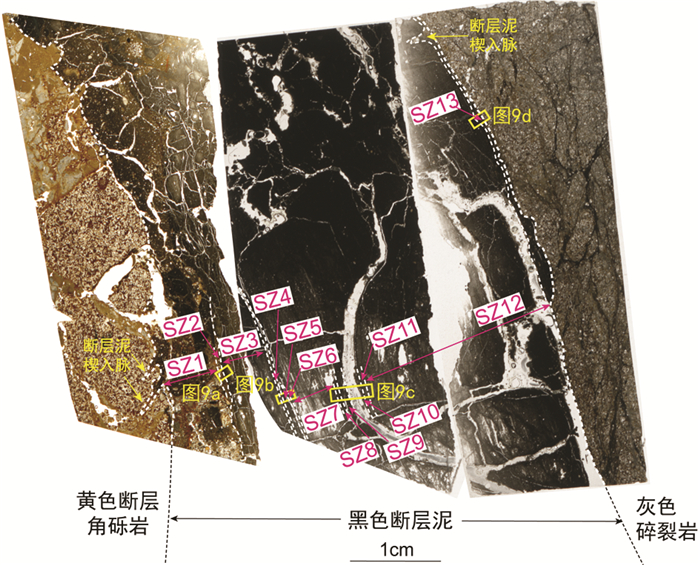
|
图 8 主滑移带断层泥连续薄片扫描图及内部滑移带划分 白色虚线代表滑移带边界 Fig. 8 Scanning image of continuous thin section of fault gouge in PSZ and division of slip zones The white dotted lines represent boundaries of slip zones |
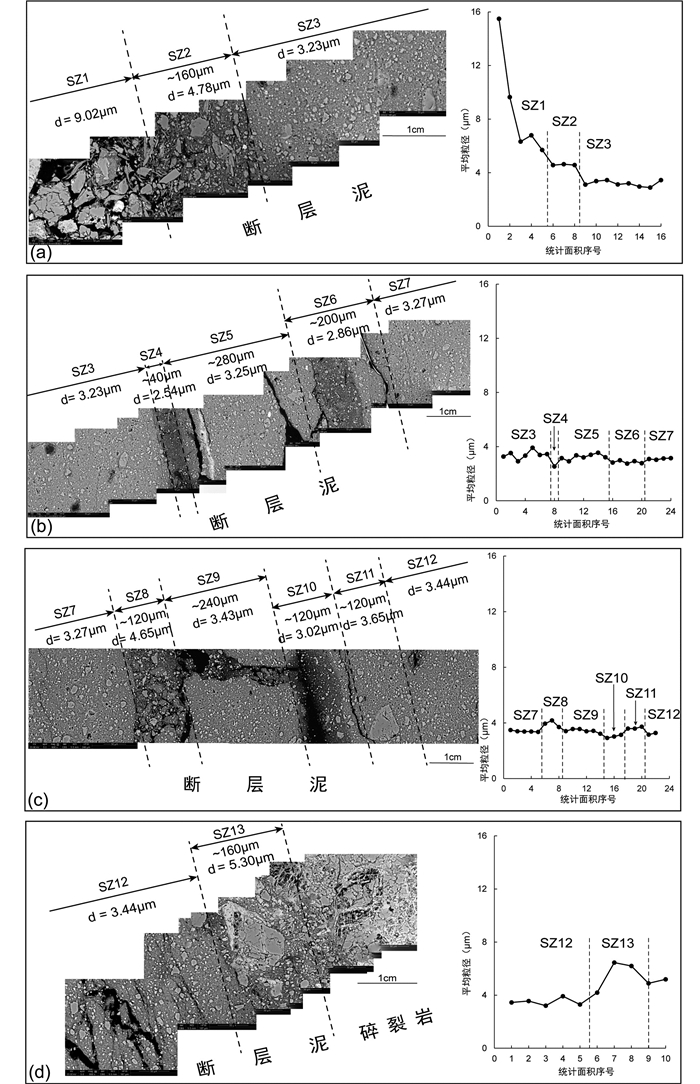
|
图 9 鲜水河断裂带乾宁段断层泥石英粒度统计分析及滑移带划分 SEM图像位置参考图 8;d代表滑移带内平均粒径 Fig. 9 Statistical analysis of quartz grain size and division of slip zones in fault gouge of Qianning segment in Xianshuihe fault zone Refer to Fig. 8 for locations of SEM images; d representing the average particle size of each slip zone |
|
|
表 1 鲜水河断裂带乾宁段断层泥内石英粒度统计分析数据表 Table 1 Statistical analysis data of quartz particle size in fault gouge of Qianning segment in Xianshuihe fault zone |
断裂岩粉末样品的XRD测试结果显示,研究剖面内断裂岩主要矿物成分为石英、斜长石、微斜长石、方解石、白云石、文石及黏土矿物(图 10)。黑色断层泥内黏土矿物主要是伊利石,靠近灰色碎裂岩的断层泥边部存在伊蒙混层。碎裂岩、断层角砾岩内则以伊利石、高岭石为主要黏土矿物。黄色断层角砾岩内可见绿蒙混层。
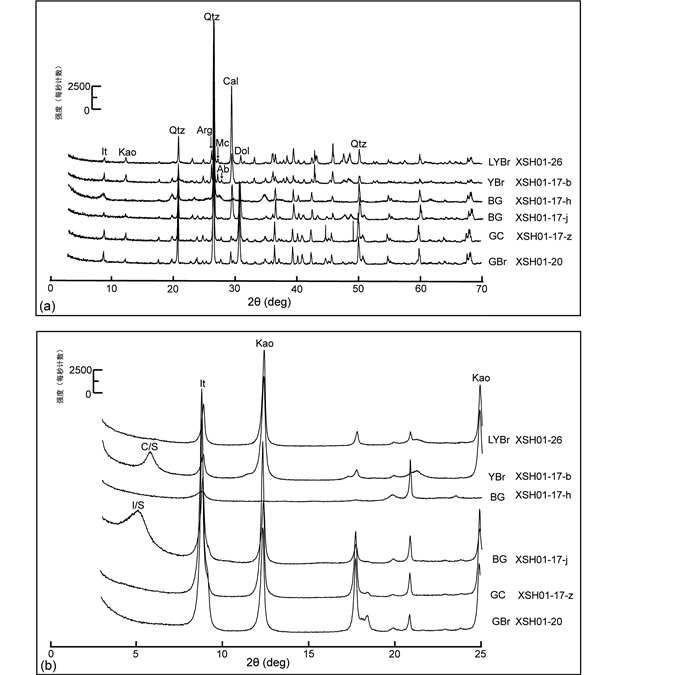
|
图 10 鲜水河断裂带乾宁段断裂岩XRD图谱 Qtz-石英;Ab-钠长石;Arg-文石;Mc-微斜长石;Cal-方解石;Dol-白云石;It-伊利石;Kao-高岭石;I/S-伊蒙混层;C/S-绿蒙混层; 断裂岩缩写参见图 4b Fig. 10 XRD patterns of fault rocks in Qianning segment of Xianshuihe fault zone Qtz-quartz; Ab-albite; Arg-aragonite; Mc-microcline; Cal-calcite; Dol-dolomite; It-illite; Kao-kaolinite; I/S-illite/smectite mixed lay; C/S-chlorite/smectite mixed lay; refer to Fig. 4b for the abbreviation of fault rocks |
黑色断层泥与碎裂岩、断层角砾岩在矿物含量变化趋势上有明显的差别(表 2、图 11)。整体来看,断层泥内方解石含量(0%~15%)低于碎裂岩、断层角砾岩(2%~35%);断层泥内黏土矿物总量(15%~27%)略高于碎裂岩(16%~22%),其中,伊利石含量(6.9%~27%)高于碎裂岩、断层角砾岩(3.2%~14.3%),而高岭石含量(0%~9.45%)低于碎裂岩、断层角砾岩(4.32%~24.12%);靠近灰色碎裂岩边部的黑色断层泥含有伊蒙混层,具有伊蒙混层含量最高(4.8%)、蒙脱石混层比最高(65%)、方解石含量高,而伊利石含量、黏土矿物总量低的矿物变化特征(图 11品红色标记的样品)。灰色碎裂岩相比于浅黄色、黄色断层角砾岩具有低方解石(2%~11%)、低高岭石(4.32%~7.7%)、高伊利石(8.32%~14.3%)、高伊蒙混层(1.36%~2.34%)的矿物含量特征。
|
|
表 2 鲜水河断裂岩乾宁段断裂岩矿物组成与含量 Table 2 Mineral composition and content of fault rocks of Qianning segment in Xianshuihe fault zone |
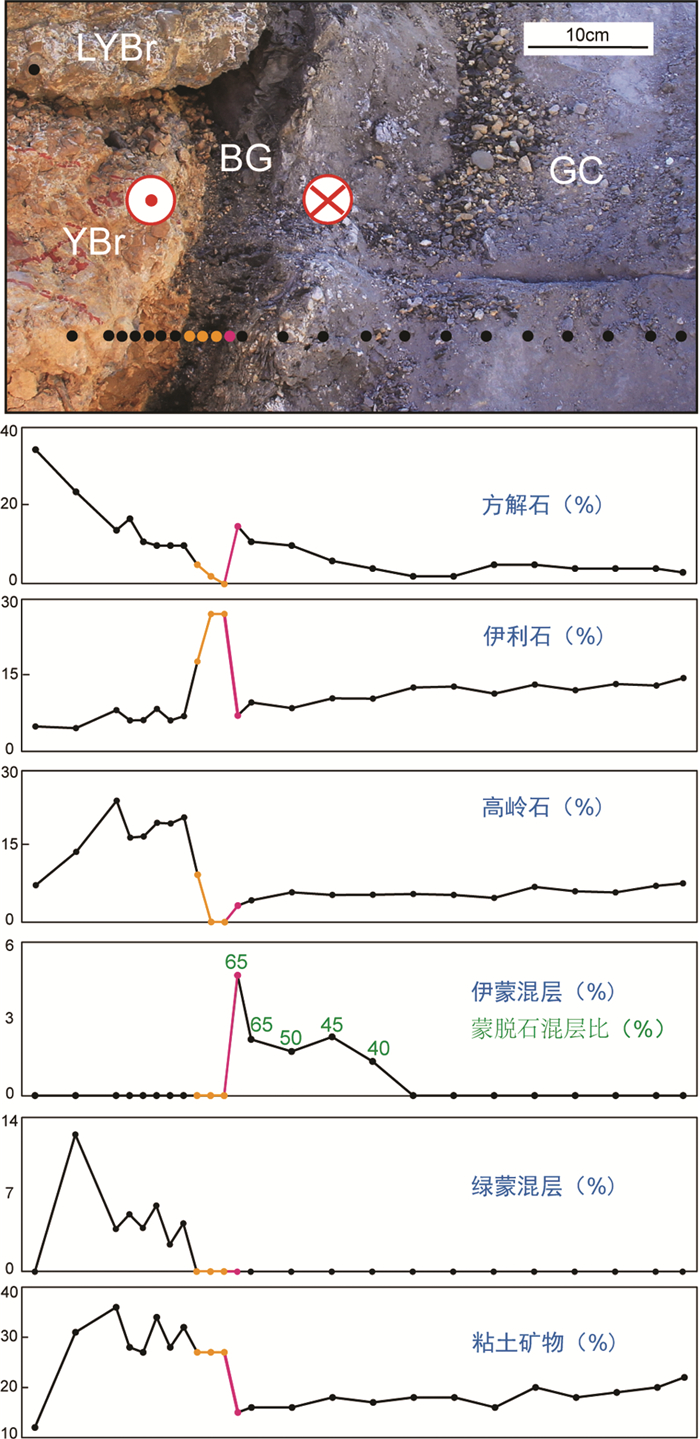
|
图 11 鲜水河断裂带乾宁段断裂岩XRD矿物含量分布图 圆点代表采样位置,黑色-断层角砾岩、碎裂岩,橘色、品红色-断层泥;断裂岩缩写参考图 4b Fig. 11 XRD mineral content analysis of fault rocks of Qianning segment in Xianshuihe fault zone Dots represent sample locations; black dots-fault breccia and cataclasite, orange and magenta-fault gouge; refer to Fig. 4b for the abbreviation of fault rocks |
我们选取黑色断层泥薄片区域进行了微区XRF元素丰度面扫描,结果显示,相对于碎裂岩、断层角砾岩,黑色断层泥内Si、K、Al富集,Ca、Fe亏损(图 12)。断层泥内元素分布并不均匀,应用扫面电镜内的EDS能谱分析对SZ13区域进行元素面扫描,结果显示SZ13中Ca、Fe含量明显高于其左侧断层泥,K略有亏损,Al、Si、Na、Mg、Ti含量变化不明显(图 13)。
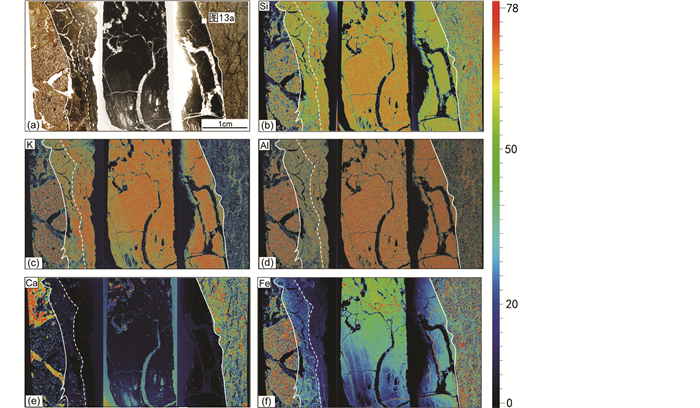
|
图 12 主滑移带黑色断层泥薄片XRF测试元素分布图 (a)主滑移带薄片扫描照片;(b-f) Si、K、Al、Ca、Fe等单元素分布图,彩色标尺代表XRF强度,红色区域表示高丰度,白色实线为断层泥与断层角砾岩、碎裂岩界线,白色虚线为断层泥内元素丰度分界线 Fig. 12 XRF elemental mapping for thin section of black fault gouge in primary slip zone (a) scanned image of primary slip zone thin sections; (b-f) single element distribution maps of Si, K, Ca, Ba, Fe, Ti and Mn; color bars represent XRF intensity; the red areas correspond to high abundance, white solid lines represent the boundaries between fault gouge and fault breccia, cataclasite, white dotted lines are the boundaries of element abundance in fault gouge |
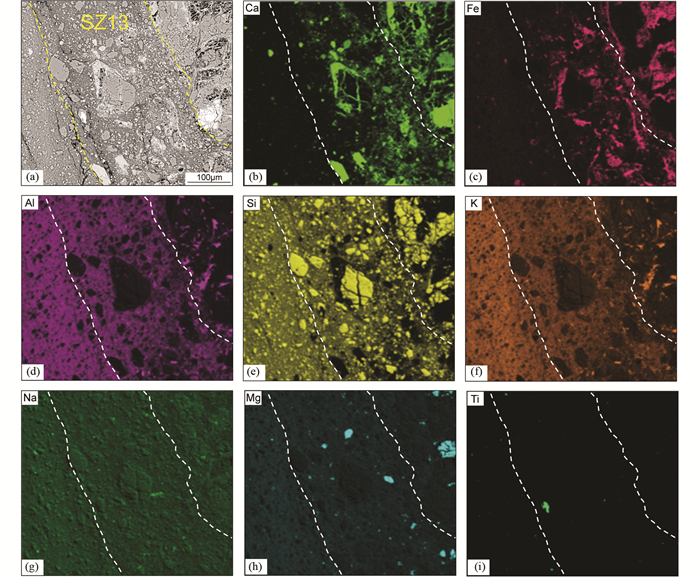
|
图 13 SZ13滑移带内元素强度分布图 (a) SZ13滑移带扫描电镜图像;图像位置参考图 12a;(b-i) Ca、Fe、Al、Si、K、Na、Mg、Ti等元素强度分布图,颜色越亮,强度越强;虚线表示SZ13边界 Fig. 13 Element distribution maps of SZ13 slip zone (a) SEM image of SZ13 slip zone; refer to Fig. 12A for the location; (b-i) element distribution map of Ca, Fe, Al, Si, K, Na, Mg, Ti, brighter color showing stronger signal; dotted lines are boundaries of SZ13 slip zone |
断裂带的内部结构可分为单核结构和多核结构(Faulkner et al., 2010),二者区别在于断裂带在地质历史过程中的变形是集中发生在同一个高应变带核部还是分散在多个高应变核部(Chester and Logan, 1986; Faulkner and Rutter, 2003)。根据变形程度,断裂带可以分为断裂核部和破碎带(Spray, 1995)。断裂带核部一般为断层滑移带,主要由富含粘土矿物的断层泥、碎裂岩或超碎裂岩和断层角砾岩组成;破碎带通常由较大范围内破碎的围岩及次级破裂组成。在研究区,鲜水河断裂带乾宁段表现为以3~5cm厚黑色断层泥和两侧发育的浅黄色、黄色断层角砾岩和灰色碎裂岩、灰色断层角砾岩为核部的单核对称结构。断层泥作为主滑移面记录了断裂带变形行为信息,其显微构造表现出断层泥中碎块大小不均、杂乱分布、磨圆度和蚀变程度不同的石英、长石碎块与极细粒的黏土矿物胶结的断层快速滑动特征,是古地震的产物(Heermance et al., 2003; 李海兵等, 2018)。
断层在地震过程中的快速滑动往往集中在一条狭窄的高应变带和主滑移面(PSS)内(Chester and Chester, 1998; Gay and Ortlepp, 1979),这种富黏土矿物的窄带可在断层动态滑动中快速降低断层面摩擦系数,从而产生大地震(Chen et al., 2001; Lin et al., 2001; Ma et al., 2001)。虽然单次古地震事件伴生的滑移带宽度已无从考量,但现今大地震后快速实施的地震断裂带科学钻探可提供一些数据参考,如中国台湾集集地震(Mw7.6)形成的断层泥有50~300μm、1mm到<2cm厚(Heermance et al., 2003; Ma et al., 2006; Kuo et al., 2011, 2014),汶川地震在映秀-北川断裂带中(WFSD-1岩心中)形成的断层泥约1mm厚(Li et al., 2014; Si et al., 2014)。由此推测,研究区内3~5cm厚断层泥可能记录了多期次的古地震事件。同一地区或相同围岩条件下,不同震级的地震破裂能不同,所形成的碎屑粒径也就不同(Ma et al., 2006)。因此,根据滑移带的厚度、碎屑粒径差异以及是否有清晰的边界或主滑移面,可划分出不同期次古地震滑移带。通过显微构造观察和石英粒度分析相结合,研究区黑色断层泥内可划分出边界清晰且与Y近乎平行、石英平均粒径稍有不同的13条滑移带。其中,SZ2、SZ4、SZ5-6、SZ8-11、SZ13等9个滑移带具有明显的边界、相异的碎屑粒径和约40~280μm不等的滑移带厚度,可代表 9次不同期次、不同震级的古地震事件。SZ1、SZ3、SZ7和SZ12虽然碎屑粒径相异,但厚度相对较大(约375~1700μm),各带内碎屑粒径趋同,不能再进一步细分滑移带。根据SZ4最窄滑移带厚度约40μm来看,上述厚度相对较大的4个滑移带很可能是由超过4次古地震形成。因此,3~5cm厚的断层泥可能代表至少13次古地震事件,甚至有可能远超过13次,其中最窄滑移带厚约40μm。
5.2 断裂滑动的弱化机制近几十年来,发震断层如何在瞬时滑动中降低摩擦阻力一直是地质学界研究的热门课题(Zoback et al., 1987; Scholz, 2002; Collettini et al., 2009)。地震过程中断层弱化往往是多种机制共同作用,如映秀-北川断裂带在2008年汶川地震中的弱化机制有摩擦熔融(Wang et al., 2019)、断层石墨化(Kuo et al., 2014)和热增压(Si et al., 2014)。这可能是由于一条断层从震源到浅表,所处深度不同,断裂作用环境(温度、压力、氧化还原环境等)也就不同,从而促发不同的断层弱化机制。目前提出的断裂带深部(4km以下)或近震源深度(10~15km)主要的断层弱化机制有:摩擦熔融(Spray, 1987; Di Toro et al., 2006)、硅胶润滑(Hirose and Shimamoto, 2005; Di Toro et al., 2006)、纳米颗粒润滑(Han et al., 2010)、热增压(Sibson, 1973)、断层石墨化(Oohashi et al., 2011)等;断裂带浅部(4km以上)黏土矿物或层状硅酸盐矿物的富集可快速弱化断层,其渗透率低,在断层摩擦热作用下易形成高压流体,弱化机制以热增压为主(Kuo et al., 2009)。因此,主滑移带内物质的化学成分和黏土矿物种类是认识地震断层浅部(4km以上)滑移机制的关键(Yamaguchi et al., 2011)。JFAST、TCDP、WFSD等地震断裂带科学钻探所获取的大地震“新鲜断层泥”中均发现了蒙脱石含量异常(Kuo et al., 2009; Yamaguchi et al., 2011; Si et al., 2014)。前人摩擦实验表明蒙脱石是已知的摩擦系数(μ=0.19~0.23)最低的矿物之一,低于伊利石、绿泥石摩擦系数(μ=0.27~0.32),进一步证实了蒙脱石很有可能是断层快速滑动引发地震的产物(Byerlee and Wyss, 1978; Ikari et al., 2009),且蒙脱石的形成往往与断层面高温及流体参与有关,指示热增压地震机制(Ujiie and Tsutsumi, 2010; Si et al., 2014)。
伊蒙混层也可以作为地震滑移带弱化的关键物质(Yamaguchi et al., 2011),这是由于孕震带高温(150~350℃, Sibson, 1982)以及断层活动引起的流体作用,尤其是富含K+、Al3+流体在孔隙中参与会使断层滑动面上的蒙脱石快速伊利石化,形成伊蒙混层。随着伊利石在伊蒙混层中百分比逐渐升高,最终全部转化为伊利石。该反应转化速率主要受温度、流体中K+、Al3+含量和流体活跃程度影响(Turner and Fishman, 1991; Eberl et al., 1993; Yamaguchi et al., 2011),反应方程式如下:1 smectite+K++Al3+→1 illite+Na++Ca2++Si4++Fe2++Mg2++H2O(Hower et al., 1976)。因此,断层面上的伊蒙混层既可以证实断层活动过程中蒙脱石的存在,同时说明断裂滑动过程中有流体的参与。
伊蒙混层也可以作为地震滑移带弱化的关键物质(Yamaguchi et al., 2011),这是由于孕震带高温(150~350℃, Sibson, 1982)以及断层活动引起的流体作用,尤其是富含K+、Al3+流体在孔隙中参与会使断层滑动面上的蒙脱石快速伊利石化,形成伊蒙混层。随着伊利石在伊蒙混层中百分比逐渐升高,最终全部转化为伊利石。该反应转化速率主要受温度、流体中K+、Al3+含量和流体活跃程度影响(Turner and Fishman, 1991; Eberl et al., 1993; Yamaguchi et al., 2011),反应方程式如下:1 smectite+K++Al3+→1 illite+Na++Ca2++Si4++Fe2++Mg2++H2O(Hower et al., 1976)。因此,断层面上的伊蒙混层既可以证实断层活动过程中蒙脱石的存在,同时说明断裂滑动过程中有流体的参与。
本文研究的主滑移带样品,即断层泥,是断裂带浅部的地震产物(Sibson, 1977; Scholz, 1988)。在黑色断层泥内侧(SZ13)与灰色碎裂岩接触处发现了高含量伊蒙混层,同时在该层伊利石含量降低,这说明该层经历过地震滑动,摩擦升温和流体共同作用下形成高压流体,降低了断层滑移带的有效正应力,断层迅速弱化,并进一步促进了蒙脱石的伊利石化反应,形成伊蒙混层。黑色断层泥中并未发现熔融物质,可能与断层滑移带内存在高压流体导致的摩擦温度不够有关(Sibson, 1973)。蒙脱石和伊利石断层泥在剪切应变加载过程具有更低的渗透率,从而导致孔隙压力增大(Ikari et al., 2009),断层面上有效正应力减小,摩擦系数降低,促进了断层弱化,由于高压流体的存在使断层泥沿T裂隙灌入形成楔入脉。因此,断层面伊蒙混层含量异常高、活跃的流体作用、断层泥低渗透率以及断层泥楔入脉的存在,表明鲜水河断裂带浅部(4km以上)在地震过程中存在热增压的动态弱化机制。
5.3 地震主滑移带迁移方向通常情况下,断裂带浅部4km以上主要形成断层角砾岩和断层泥,而在4km以下或近震源深度(10~15km)则会形成碎裂岩或在干的环境下形成假玄武玻璃等(Sibson, 1977; Scholz, 1988)。假玄武玻璃和断层泥在断层破裂后愈合方面起到截然相反作用:熔融体冷却后具有焊接强化断层的作用(Mitchell et al., 2016; Proctor and Locker, 2016);断层泥主要由黏土矿物组成,层状硅酸盐矿物的增多使得断层变弱(Collettini et al., 2009),同时具有低渗透率和高孔隙流体压力,更容易发生断层滑动(Numelin et al., 2007; Ikari et al., 2009; Ujiie and Tsutsumi, 2010)。自然界中断层泥可以厚到十几厘米(Ma et al., 2006; Chester et al., 2013),而单次地震形成的断层泥只有几十微米到几毫米厚,说明“过厚”的断层泥容纳了多期次地震活动。研究各地震事件发生的时间顺序将有助于探索地震主滑移带在地质历史时期的迁移方向或趋势。
本文研究区内的鲜水河断裂带主滑移带断层泥厚3~5cm,由13个滑移带(SZ1~SZ13)组成,是≥13次地震事件的累计产物。断层泥与灰色碎裂岩、灰色断层角砾岩在矿物成份上相似,只是在各类矿物含量高低上有所差异,推测三者都是由灰色砂岩、粉砂岩发育而来。扫描电镜观测到靠近黄色断层角砾岩的SZ1-2在碎屑成分和内部结构上与其他滑移带略有差别,SZ1-2中长石、云母含量相对较高,石英、长石碎屑多发生蚀变,云母在SZ1与SZ2交界处异常聚集并具有弱定向,方解石以碎屑颗粒形式出现在断层泥内。这可能是由于黄色断层角砾岩参与了SZ1-2的形成过程,并在断层泥形成后遭受长期流体作用,使碎屑颗粒蚀变程度较其他滑移带更为严重,推测SZ1-2是主滑移带内相对早期的产物。XRD结果显示出在靠近碎裂岩的黑色断层泥的SZ13带与其两侧相比具有高方解石、高伊蒙混层、低伊利石、低黏土矿物的矿物特征,这与TCDP中1999年集集地震(Kuo et al., 2009)和IODP中1944年Tonankaidi地震主滑移带矿物变化特征较为相似(Yamaguchi et al., 2011),进一步表明了SZ13可能是相对其他滑移带是最新一次古地震事件的主滑动带。此外,SZ13内元素分布特征与其左侧断层泥并不相同,SZ13内Fe、Ca富集,K略亏损,而左侧断层泥内K、Al富集,Ca、Fe亏损严重,且SZ13内可见间震期流体作用通过溶解-沉淀产生碳酸盐矿物愈合破裂的特征。从断层泥不同滑动带(SZ1~SZ13)中碎块蚀变程度相对越来越低且Ca、Fe元素分布越来越高特征来看,地震主滑动带有向碎裂岩方向迁移的趋势。由此可见,研究区内鲜水河断裂带地震活动主滑移带始终发育在灰色砂岩、粉砂岩围岩一侧,SZ13为最新一次古地震事件的主滑移带,多期次地震滑移具有向灰色碎裂岩方向迁移的趋势。这可能是由于灰色碎裂岩相对于浅黄色、黄色角砾岩在矿物成分上表现为弱矿物含量高(如伊利石、伊蒙混层),而强矿物含量低(如方解石、高岭石)的因素。由此我们推测,断层在滑动过程中,更趋向于向弱矿物含量高的围岩一侧迁移。
6 结论本文对鲜水河断裂带乾宁段甘孜州八美镇龙灯乡促涅隆巴河沟内地表露头断裂岩开展了详细的岩石组成、结构构造、物理-化学性质综合研究,得出以下认识:
(1) 鲜水河断裂带乾宁段呈单核对称结构,核部岩石由黑色断层泥、浅黄色及黄色断层角砾岩和灰色碎裂岩、灰色断层角砾岩组成。3~5cm厚断层泥是地震快速滑动产物。断层泥内部识别出的13个滑移带代表至少13期古地震事件,最窄滑移带厚约40μm。
(2) 相对最新一次古地震主滑移带内伊蒙混层含量异常高,加之蒙脱石、伊利石为主要黏土矿物的断层泥渗透率低、孔隙流体压力大,以及由于滑动带内高压流体存在而形成的断层泥楔入脉,表明鲜水河断裂带在地震过程中存在热增压的动态弱化机制。
(3) 黑色断层泥内记录的多期古地震主滑移带均发育在灰色砂岩、粉砂岩围岩一侧,且有向灰色碎裂岩方向迁移的趋势。推测断层在滑动过程中,更趋向于向弱矿物含量高、强矿物含量低的围岩一侧迁移。
致谢 感谢汶川地震断裂科学钻探工程实验中心魏金川和吴建国在薄片制备和样品采集时给予的诸多帮助;感谢中国地质科学院地质研究所施斌博士在扫描电镜观察中的技术指导;感谢二位审稿人中国地震局地质研究所周永胜研究员、任治坤研究员以及本刊编辑对本文提出的宝贵修改意见,使本文质量得以提升。
Allen CR, Luo ZL, Qian H, Wen XZ, Zhou HW and Huang WS. 1991. Field study of a highly active fault zone: The Xianshuihe fault of southwestern China. Geological Society of America Bulletin, 103(9): 1178-1199 DOI:10.1130/0016-7606(1991)103<1178:FSOAHA>2.3.CO;2
|
Bai MK, Chevalier ML, Pan JW, Replumaz A, Leloup PH, Métois M and Li HB. 2018. Southeastward increase of the Late Quaternary slip-rate of the Xianshuihe fault, eastern Tibet. Geodynamic and seismic hazard implications. Earth and Planetary Science Letters, 485: 19-31 DOI:10.1016/j.epsl.2017.12.045
|
Byerlee JD and Wyss M. 1978. Rock Friction and Earthquake Prediction. Basel: Birkhäuser, 615-626
|
Chen WS, Huang BS, Chen YG, Lee YH, Yang CN, Lo CH, Chang HC, Sung QC, Huang NW, Lin CC, Sung SH and Lee KJ. 2001. 1999 Chi-Chi earthquake: A case study on the role of thrust-ramp structures for generating earthquakes. Bulletin of the Seismological Society of America, 91(5): 986-994
|
Chester FM and Logan JM. 1986. Implications for mechanical properties of brittle faults from observations of the Punchbowl fault zone, California. Pure and Applied Geophysics, 124(1): 79-106
|
Chester FM, Evans JP and Biegel RL. 1993. Internal structure and weakening mechanisms of the San Andreas Fault. Journal of Geophysical Research: Solid Earth, 98(B1): 771-786 DOI:10.1029/92JB01866
|
Chester FM and Chester JS. 1998. Ultracataclasite structure and friction processes of the Punchbowl fault, San Andreas system, California. Tectonophysics, 295(1-2): 199-221 DOI:10.1016/S0040-1951(98)00121-8
|
Chester FM, Rowe C, Ujiie K, Kirkpatrick J, Regalla C, Remitti F, Moore JC, Toy V, Wolfson-Schwehr M, Bose S, Kameda J, Mori JJ, Brodsky EE, Eguchi N, Toczko S and Expedition 343 and 343T Scientists. 2013. Structure and composition of the plate-boundary slip zone for the 2011 Tohoku-Oki earthquake. Science, 342(6163): 1208-1211 DOI:10.1126/science.1243719
|
Collettini C, Niemeijer A, Viti C and Marone C. 2009. Fault zone fabric and fault weakness. Nature, 462(7275): 907-910 DOI:10.1038/nature08585
|
Deng QD, Zhang PZ, Ran YK, Yang XP, Min W and Chu QZ. 2003. Basic characteristics of active tectonics of China. Science in China (Series D), 46(4): 356-372
|
Di Toro G, Hirose T, Nielsen S, Pennacchioni G and Shimamoto T. 2006. Natural and experimental evidence of melt lubrication of faults during earthquakes. Science, 311(5761): 647-649 DOI:10.1126/science.1121012
|
Eberl DD, Velde B and McCormick T. 1993. Synthesis of illite-smectite from smectite at earth surface temperatures and high pH. Clay Minerals, 28(1): 49-60 DOI:10.1180/claymin.1993.028.1.06
|
Faulkner DR and Rutter EH. 2003. The effect of temperature, the nature of the pore fluid, and subyield differential stress on the permeability of phyllosilicate-rich fault gouge. Journal of Geophysical Research: Solid Earth, 108(B5): 2227
|
Faulkner DR, Jackson CAL, Lunn RJ, Schlische RW, Shipton ZK, Wibberley CAJ and Withjack MO. 2010. A review of recent developments concerning the structure, mechanics and fluid flow properties of fault zones. Journal of Structural Geology, 32(11): 1557-1575 DOI:10.1016/j.jsg.2010.06.009
|
Gay NC and Ortlepp WD. 1979. Anatomy of a mining-induced fault zone. GSA Bulletin, 90(1): 47-58 DOI:10.1130/0016-7606(1979)90<47:AOAMFZ>2.0.CO;2
|
Gratier JP, Richard J, Renard F, Mittempergher S, Doan ML, Di Toro G, Hadizadeh J and Boullier AM. 2011. Aseismic sliding of active faults by pressure solution creep: Evidence from the San Andreas Fault Observatory at Depth. Geology, 39(12): 1131-1134 DOI:10.1130/G32073.1
|
Gu XD and Liu XH. 1997. Stratigraphy(lithostratic) of Sichuan Province. Wuhan: China University of Geosciences Press, 167-189 (in Chinese with English abstract)
|
Han R, Hirose T and Shimamoto T. 2010. Strong velocity weakening and powder lubrication of simulated carbonate faults at seismic slip rates. Journal of Geophysical Research: Solid Earth, 115: B30412
|
Heermance R, Shipton ZK and Evans JP. 2003. Fault structure control on fault slip and ground motion during the 1999 rupture of the Chelungpu fault, Taiwan. Bulletin of the Seismological Society of America, 93(3): 1034-1050 DOI:10.1785/0120010230
|
Hirose T and Shimamoto T. 2005. Growth of molten zone as a mechanism of slip weakening of simulated faults in gabbro during frictional melting. Journal of Geophysical Research: Solid Earth, 110: B05202
|
Holdsworth RE, van Diggelen EWE, Spiers CJ, de Bresser JHP, Walker RJ and Bowen L. 2011. Fault rocks from the SAFOD core samples: Implications for weakening at shallow depths along the San Andreas Fault, California. Journal of Structural Geology, 33(2): 132-144 DOI:10.1016/j.jsg.2010.11.010
|
Hower J, Eslinger EV, Hower ME and Perry EA. 1976. Mechanism of burial metamorphism of argillaceous sediment: 1. Mineralogical and chemical evidence. Geological Society of America Bulletin, 87(5): 725-737 DOI:10.1130/0016-7606(1976)87<725:MOBMOA>2.0.CO;2
|
Ikari MJ, Saffer DM and Marone C. 2009. Frictional and hydrologic properties of clay-rich fault gouge. Journal of Geophysical Research: Solid Earth, 114(B5): B05409
|
Ji LY, Zhang WT, Liu CJ, Zhu LY, Xu J and Xu XX. 2020. Characterizing interseismic deformation of the Xianshuihe fault, eastern Tibetan Plateau, using Sentinel-1 SAR images. Advances in Space Research, 66(2): 378-394 DOI:10.1016/j.asr.2020.03.043
|
Jiang GY, Xu XW, Chen GH, Liu YJ, Fukahata Y, Wang H, Yu GH, Tan XB and Xu CJ. 2015. Geodetic imaging of potential seismogenic asperities on the Xianshuihe-Anninghe-Zemuhe fault system, Southwest China, with a new 3-D viscoelastic interseismic coupling model. Journal of Geophysical Research: Solid Earth, 120(3): 1855-1873 DOI:10.1002/2014JB011492
|
Kuo LW, Song SR, Yeh EC and Chen HF. 2009. Clay mineral anomalies in the fault zone of the Chelungpu Fault, Taiwan, and their implications. Geophysical Research Letters, 36(18): L18306 DOI:10.1029/2009GL039269
|
Kuo LW, Song SR, Huang L, Yeh EC and Chen HF. 2011. Temperature estimates of coseismic heating in clay-rich fault gouges, the Chelungpu fault zones, Taiwan. Tectonophysics, 502(3-4): 315-327 DOI:10.1016/j.tecto.2011.02.001
|
Kuo LW, Li HB, Smith SAF, Di Toro G, Suppe J, Song SR, Nielsen S, Sheu HS and Si JL. 2014. Gouge graphitization and dynamic fault weakening during the 2008 Mw 7.9 Wenchuan earthquake. Geology, 42(1): 47-50 DOI:10.1130/G34862.1
|
Li DY, Chen LC, Liang MJ, Gao SP, Zeng D, Wang H and Li YB. 2017. Holocene palaeoseismologic record and rupture behavior of large earthquakes on the Xianshuihe fault. Seismology and Geology, 39(4): 623-643 (in Chinese with English abstract)
|
Li HB, Xu ZQ, Niu YX, Kong GS, Huang Y, Wang H, Si JL, Sun ZM, Pei JL, Gong Z, Chevalier ML and Liu DL. 2014. Structural and physical property characterization in the Wenchuan earthquake Fault Scientific Drilling project-hole 1 (WFSD-1). Tectonophysics, 619-620: 86-100 DOI:10.1016/j.tecto.2013.08.022
|
Li HB, Xu ZQ, Wang H, Zhang L, He XL, Si JL and Sun ZM. 2018. Fault behavior, physical properties and seismic activity of the Wenchuan earthquake fault zone: Evidences from the Wenchuan earthquake Fault Scientific Drilling project (WFSD). Chinese Journal of Geophysics, 61(5): 1680-1697 (in Chinese with English abstract)
|
Lin A, Ouchi T, Chen A and Maruyama T. 2001. Co-seismic displacements, folding and shortening structures along the Chelungpu surface rupture zone occurred during the 1999 Chi-Chi (Taiwan) earthquake. Tectonophysics, 330(3-4): 225-244 DOI:10.1016/S0040-1951(00)00230-4
|
Ma KF, Mori J, Lee SJ and Yu SB. 2001. Spatial and temporal distribution of slip for the 1999 Chi-Chi, Taiwan, earthquake. Bulletin of the Seismological Society of America, 91(5): 1069-1087
|
Ma KF, Tanaka H, Song SR, Wang CY, Hung JH, Tsai YB, Mori J, Song YF, Yeh EC, Soh W, Sone H, Kuo LW and Wu HY. 2006. Slip zone and energetics of a large earthquake from the Taiwan Chelungpu-fault Drilling Project. Nature, 444(7118): 473-476 DOI:10.1038/nature05253
|
Mitchell TM, Toy V, Di Toro G, Renner J and Sibson RH. 2016. Fault welding by pseudotachylyte formation. Geology, 44(12): 1059-1062 DOI:10.1130/G38373.1
|
Molnar P and Tapponnier P. 1975. Cenozoic tectonics of Asia: Effects of a continental collision. Science, 189(4201): 419-426 DOI:10.1126/science.189.4201.419
|
Molnar P and Deng QD. 1984. Faulting associated with large earthquakes and the average rate of deformation in central and eastern Asia. Journal of Geophysical Research: Solid Earth, 89(B7): 6203-6227 DOI:10.1029/JB089iB07p06203
|
Numelin T, Marone C and Kirby E. 2007. Frictional properties of natural fault gouge from a low-angle normal fault, Panamint Valley, California. Tectonics, 26(2): TC2004
|
Oohashi K, Hirose T and Shimamoto T. 2011. Shear-induced graphitization of carbonaceous materials during seismic fault motion: Experiments and possible implications for fault mechanics. Journal of Structural Geology, 33(6): 1122-1134 DOI:10.1016/j.jsg.2011.01.007
|
Pan JW, Li HB, Chevalier ML, Bai MK, Liu FC, Liu DL, Zheng Y, Lu HJ and Zhao ZB. 2020. A newly discovered active fault on the Selaha-Kangding segment along the SE Xianshuihe fault: The South Mugecuo fault. Acta Geologica Sinica, 94(11): 3178-3188 (in Chinese with English abstract)
|
Papadimitriou E, Wen XZ, Karakostas V and Jin XS. 2004. Earthquake Triggering along the Xianshuihe Fault Zone of western Sichuan, China. Pure and Applied Geophysics, 161(8): 1683-1707 DOI:10.1007/s00024-003-2471-4
|
Parsons T, Ji C and Kirby E. 2008. Stress changes from the 2008 Wenchuan earthquake and increased hazard in the Sichuan basin. Nature, 454(7203): 509-510 DOI:10.1038/nature07177
|
Peng D, Fan X, Wang ZC, Xu G, Shao ZW and Hou BP. 2012. Preliminary study of the earth pillars in Dandu, Luhuo, Xianshuihe fracture zone. Acta Geologica Sichuan, 32(1): 6-9 (in Chinese with English abstract)
|
Proctor B and Lockner DA. 2016. Pseudotachylyte increases the post-slip strength of faults. Geology, 44(12): 1003-1006 DOI:10.1130/G38349.1
|
Schleicher AM, van der Pluijm BA and Warr LN. 2010. Nanocoatings of clay and creep of the San Andreas fault at Parkfield, California. Geology, 38(7): 667-670 DOI:10.1130/G31091.1
|
Scholz CH. 1988. The brittle-plastic transition and the depth of seismic faulting. Geologische Rundschau, 77(1): 319-328 DOI:10.1007/BF01848693
|
Scholz CH. 2002. The Mechanics of Earthquakes and Faulting. 2nd Edition. Cambridge: Cambridge University Press, 1-49
|
Si JL, Li HB, Kuo LW, Pei JL, Song SR and Wang H. 2014. Clay mineral anomalies in the Yingxiu-Beichuan fault zone from the WFSD-1 drilling core and its implication for the faulting mechanism during the 2008 Wenchuan earthquake (Mw 7.9). Tectonophysics, 619-620: 171-178 DOI:10.1016/j.tecto.2013.09.022
|
Sibson RH. 1973. Interactions between temperature and pore-fluid pressure during earthquake faulting and a mechanism for partial or total stress relief. Nature Physical Science, 243(126): 66-68 DOI:10.1038/physci243066a0
|
Sibson RH. 1977. Fault rocks and fault mechanisms. Journal of the Geological Society, 133(3): 191-213 DOI:10.1144/gsjgs.133.3.0191
|
Sibson RH. 1982. Fault zone models, heat flow, and the depth distribution of earthquakes in the continental crust of the United States. Bulletin of the Seismological Society of America, 72(1): 151-163
|
Spray JG. 1987. Artificial generation of pseudotachylyte using friction welding apparatus: simulation of melting on a fault plane. Journal of Structural Geology, 9(1): 49-60 DOI:10.1016/0191-8141(87)90043-5
|
Spray JG. 1995. Pseudotachylyte controversy: Fact or friction?. Geology, 23(12): 1119-1122 DOI:10.1130/0091-7613(1995)023<1119:PCFOF>2.3.CO;2
|
Tapponnier P and Molnar P. 1977. Active faulting and tectonics in China. Journal of Geophysical Research, 82(20): 2905-2930 DOI:10.1029/JB082i020p02905
|
Tapponnier P, Xu ZQ, Roger F, Meyer B, Arnaud N, Wittlinger G and Yang JS. 2001. Oblique stepwise rise and growth of the Tibet Plateau. Science, 294(5547): 1671-1677 DOI:10.1126/science.105978
|
Toda S, Lin J, Meghraoui M and Stein RS. 2008. 12 May 2008 M=7.9 Wenchuan, China, earthquake calculated to increase failure stress and seismicity rate on three major fault systems. Geophysical Research Letters, 35(17): L17305 DOI:10.1029/2008GL034903
|
Turner CE and Fishman NS. 1991. Jurassic Lake T'oo'dichi': A large alkaline, saline lake, Morrison Formation, eastern Colorado Plateau. Geological Society of America Bulletin, 103(4): 538-558 DOI:10.1130/0016-7606(1991)103<0538:JLTODA>2.3.CO;2
|
Ujiie K and Tsutsumi A. 2010. High-velocity frictional properties of clay-rich fault gouge in a megasplay fault zone, Nankai subduction zone. Geophysical Research Letters, 37(24): L24310
|
Wang E and Burchfiel BC. 2000. Late Cenozoic to Holocene deformation in southwestern Sichuan and adjacent Yunnan, China, and its role in formation of the southeastern part of the Tibetan Plateau. Geological Society of America Bulletin, 112(3): 413-423 DOI:10.1130/0016-7606(2000)112<413:LCTHDI>2.0.CO;2
|
Wang H, Li HB, Si JL, Zhang L and Sun ZM. 2019. Geochemical features of the pseudotachylytes in the Longmen Shan thrust belt, eastern Tibet. Quaternary International, 514: 173-185 DOI:10.1016/j.quaint.2018.12.030
|
Wang M and Shen ZK. 2020. Present-day crustal deformation of continental China derived from GPS and its tectonic implications. Journal of Geophysical Research: Solid Earth, 125(2): e2019JB018774
|
Wang W, Qiao XJ, Yang SM and Wang DJ. 2017. Present-day velocity field and block kinematics of Tibetan Plateau from GPS measurements. Geophysical Journal International, 208(2): 1088-1102 DOI:10.1093/gji/ggw445
|
Wang Y, Zhang B, Hou JJ and Xu XW. 2014. Structure and tectonic geomorphology of the Qujiang fault at the intersection of the Ailao Shan-Red River fault and the Xianshuihe-Xiaojiang fault system, China. Tectonophysics, 634: 156-170 DOI:10.1016/j.tecto.2014.07.031
|
Wen XZ, Allen CR, Luo ZL, Qian H, Zhou HW and Huang WS. 1989. Segmentation, geomwtric features, and their seismotectonic implications for the Holocene Xianshuihe fault zone. Acta Seismologica Sinica, 11(4): 362-372 (in Chinese with English abstract)
|
Wen XZ, Ma SL, Xu XW and He YN. 2008. Historical pattern and behavior of earthquake ruptures along the eastern boundary of the Sichuan-Yunnan faulted-block, southwestern China. Physics of the Earth and Planetary Interiors, 168(1-2): 16-36 DOI:10.1016/j.pepi.2008.04.013
|
Wibberley CAJ, Yielding G and Di Toro G. 2008. Recent advances in the understanding of fault zone internal structure: A review. Geological Society, London, Special Publications, 299(1): 5-33 DOI:10.1144/SP299.2
|
Yamaguchi A, Sakaguchi A, Sakamoto T, Iijima K, Kameda J, Kimura G, Ujiie K, Chester FM, Fabbri O, Goldsby D, Tsutsumi A, Li CF and Curewitz D. 2011. Progressive illitization in fault gouge caused by seismic slip propagation along a megasplay fault in the Nankai Trough. Geology, 39(11): 995-998 DOI:10.1130/G32038.1
|
Yan B and Lin AM. 2015. Systematic deflection and offset of the Yangtze River drainage system along the strike-slip Ganzi-Yushu-Xianshuihe Fault Zone, Tibetan Plateau. Journal of Geodynamics, 87: 13-25 DOI:10.1016/j.jog.2015.03.002
|
Yang W, Cheng J, Liu J and Zhang XM. 2015. The Kangding earthquake swarm of November, 2014. Earthquake Science, 28(3): 197-207 DOI:10.1007/s11589-015-0123-2
|
Yang ZE, Guo F, Li TM and Lü YP. 1999. The characteristics of fault gouges from the Xianshuihe fault zone and its geological implications. Seismology and Geology, 21(1): 21-28 (in Chinese with English abstract)
|
Zhang PZ, Wang M, Gan WJ and Deng QD. 2003. Slip rates along major active faults from GPS measurements and constraints on contemporary continental tectonics. Earth Science Frontiers, 10(Suppl.1): 81-92 (in Chinese with English abstract)
|
Zhang PZ, Shen ZK, Wang M, Gan WJ, Burgmann R, Molnar P, Wang Q, Niu ZJ, Sun JZ, Wu JC, Sun HR and You XZ. 2004a. Continuous deformation of the Tibetan Plateau from global positioning system data. Geology, 32(9): 809-812 DOI:10.1130/G20554.1
|
Zhang PZ. 2013. A review on active tectonics and deep crustal processes of the western Sichuan region, eastern margin of the Tibetan Plateau. Tectonophysics, 584: 7-22 DOI:10.1016/j.tecto.2012.02.021
|
Zhang YQ, Chen W and Yang N. 2004b. 40Ar/39Ar dating of shear deformation of the Xianshuihe fault zone in west Sichuan and its tectonic significance. Science in China (Series D), 47(9): 794-803
|
Zhang YS, Yang ZH, Guo CB, Wang T, Wang DH and Du GL. 2017. Predicting landslide scenes under potential earthquake scenarios in the Xianshuihe fault zone, Southwest China. Journal of Mountain Science, 14(7): 1262-1278 DOI:10.1007/s11629-017-4363-6
|
Zoback MD, Zoback ML, Mount VS, Suppe J, Eaton JP, Healy JH, Oppenheimer D, Reasenberg P, Jones L, Raleigh BC, Wong IG, Scotti O and Wentworth C. 1987. New evidence on the state of stress of the San Andreas fault system. Science, 238(4830): 1105-1111 DOI:10.1126/science.238.4830.1105
|
辜学达, 刘啸虎. 1997. 四川省岩石地层. 武汉: 中国地质大学出版社, 167-189.
|
李东雨, 陈立春, 梁明剑, 高帅坡, 曾蒂, 王虎, 李彦宝. 2017. 鲜水河断裂带乾宁段古地震事件与大震复发行为. 地震地质, 39(4): 623-643. DOI:10.3969/j.issn.0253-4967.2017.04.001 |
李海兵, 许志琴, 王焕, 张蕾, 何祥丽, 司家亮, 孙知明. 2018. 汶川地震断裂带滑移行为、物理性质及其大地震活动性——来自汶川地震断裂带科学钻探的证据. 地球物理学报, 61(5): 1680-1697. |
潘家伟, 李海兵, Chevalier ML, 白明坤, 刘富财, 刘栋梁, 郑勇, 卢海建, 赵中宝. 2020. 鲜水河断裂带色拉哈-康定段新发现的活动断层: 木格措南断裂. 地质学报, 94(11): 3178-3188. DOI:10.3969/j.issn.0001-5717.2020.11.002 |
彭东, 范晓, 王兆成, 徐刚, 邵志伟, 侯宝平. 2012. 鲜水河断裂带炉霍旦都土林构造初步研究. 四川地质学报, 32(1): 6-9. DOI:10.3969/j.issn.1006-0995.2012.01.002 |
闻学泽, Allen CR, 罗灼礼, 钱洪, 周华伟, 黄伟师. 1989. 鲜水河全新世断裂带的分段性、几何特征及其地震构造意义. 地震学报, 11(4): 362-372. |
杨主恩, 郭芳, 李铁明, 吕弋培. 1999. 鲜水河断裂西北段的断层泥特征及其地震地质意义. 地震地质, 21(1): 21-28. DOI:10.3969/j.issn.0253-4967.1999.01.003 |
张培震, 王敏, 甘卫军, 邓起东. 2003. GPS观测的活动断裂滑动速率及其对现今大陆动力作用的制约. 地学前缘, 10(增1): 81-92. |
 2021, Vol. 37
2021, Vol. 37


